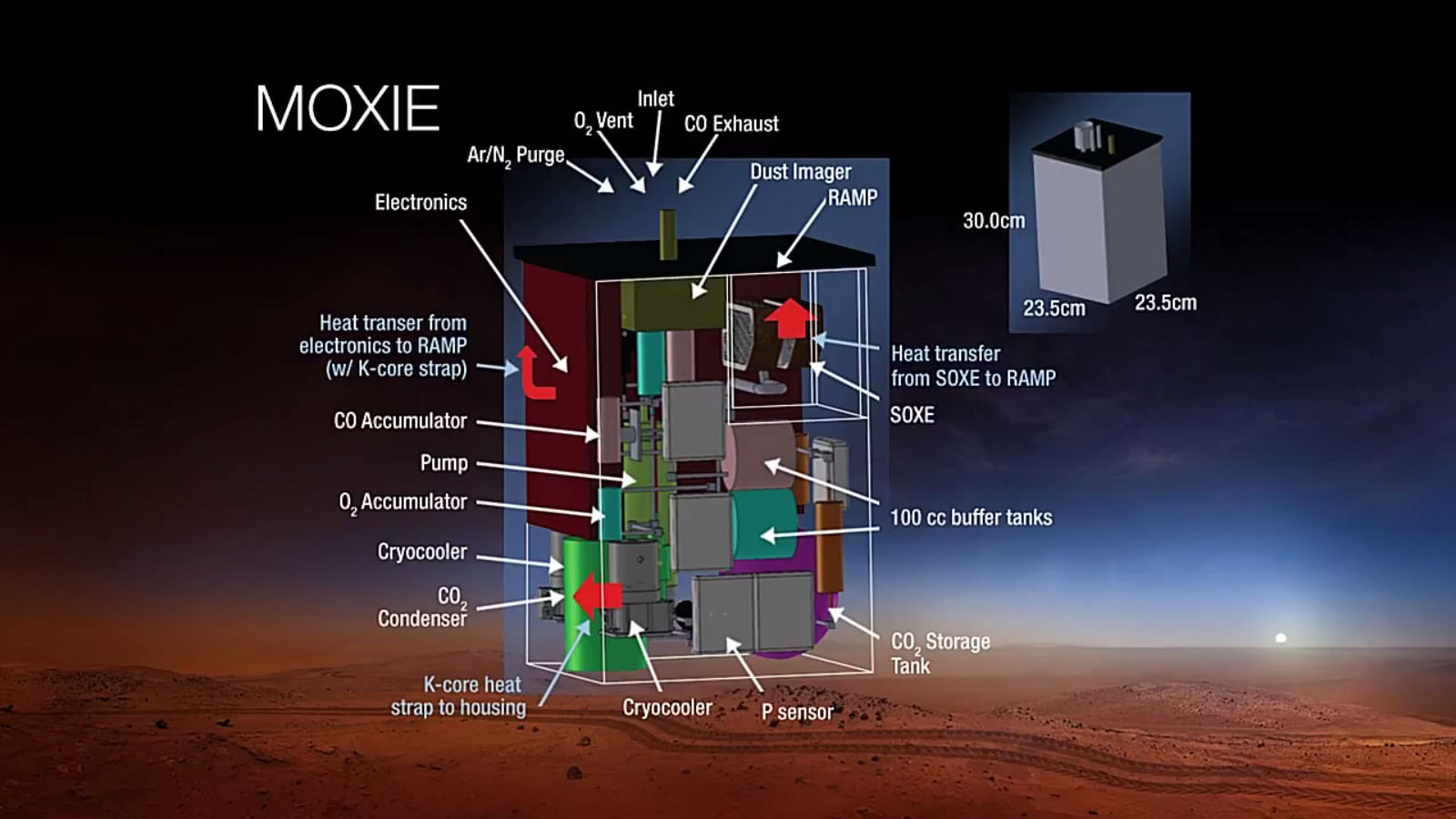Here's how the Perseverance landing could pave the way for humans on Mars
There's no breathing easy on Mars.

Tucked in the belly of NASA's Mars Perseverance rover is a golden box that, if all goes well, will turn some of the Red Planet's thin, carbon-dioxide-rich atmosphere into sweet, sweet oxygen.
The experiment, called Mars Oxygen In-Situ Resource Utilization Experiment (MOXIE), is meant to demonstrate technology that could one day support a crewed mission to Mars, since oxygen is a vital resource for humans to breathe and rockets to burn. And with the Perseverance rover due to touch down on the Red Planet tomorrow (Feb. 18), the MOXIE team is excited to be one step closer to the experiment's first test.
"MOXIE is intended to be a demonstration of a technology that will allow us to fill up the oxygen tanks that a team of future astronauts will need to fly home, to take off from Mars," the experiment's principal investigator, Michael Hecht, an experimental scientist at the Massachusetts Institute of Technology's Haystack Observatory, told Space.com. "Also to breathe, but rockets breathe more than people and that's the big job."
Related: How to watch NASA's Perseverance rover land on Mars
Perseverance rover's Mars landing: Everything you need to know
Book of Mars: $22.99 at Magazines Direct
Within 148 pages, explore the mysteries of Mars. With the latest generation of rovers, landers and orbiters heading to the Red Planet, we're discovering even more of this world's secrets than ever before. Find out about its landscape and formation, discover the truth about water on Mars and the search for life, and explore the possibility that the fourth rock from the sun may one day be our next home.
Neither humans nor rockets will breathe MOXIE's oxygen; it's just testing a concept.
However, MOXIE has long roots: NASA considered flying a predecessor on a 2001 mission, Hecht said. But when NASA was dreaming up the Mars 2020 mission, the agency specified it wanted to fly an instrument to produce propellant from materials found on Mars, and work on MOXIE began.
But MOXIE's designers weren't starting from scratch. The device is essentially the reverse of a fuel cell, which burns a mix of oxygen and a carbon-based compound to produce heat and carbon dioxide. The instrument also closely resembles a significantly more mundane object. "Of course, MOXIE is a little tree, right?" Hecht said. "Trees take [carbon dioxide] and turn it into oxygen with a much more complicated chemical process."
Get the Space.com Newsletter
Breaking space news, the latest updates on rocket launches, skywatching events and more!
For Hecht, MOXIE's arrival at Mars marks a real milestone toward someday sending humans to the Red Planet.
"When I first got involved in this in the mid-'90s, it was 15 years off. It's still 15 years off," he said of a crewed mission. "This is really the first substantial investment, major investment by NASA in demonstrating technology for humans going to Mars. And to me, it's a way of NASA saying, 'We're serious about this, we're going to make it happen.'" (MOXIE cost about $50 million, he said.)
7 minutes of terror: See the nail-biting Mars landing of the Perseverance rover
How it works
MOXIE is hitching a ride on the spacecraft as a technology demonstration, rather than meeting one of the Perseverance rover's core goal of looking for traces of ancient life, so its work is not the highest priority on the mission. And MOXIE will only operate occasionally — perhaps just once every few months, or about as frequently as the Perseverance rover will drill for samples.
That's because the technology requires a steep energy input in order to heat a key component of the experiment to about 1,500 degrees Fahrenheit (800 degrees Celsius). Each time MOXIE runs, the instrument will spend about two hours warming up, then produce oxygen for about one hour. That process will use most of the rover's power supply for the day. (The dramatic temperature swings also posed a design challenge, since materials don't take such treatment kindly.)
MOXIE can't produce oxygen out of nowhere, of course: The instrument will pull carbon dioxide out of the thin Martian atmosphere, which is 100 times thinner than Earth's. Just that step is quite tricky, particularly given how high in altitude Perseverance will land.
"The atmosphere is thin, and we have to collect a lot of it," Hecht said. "Where we're landing with Perseverance, compared to, say, Curiosity or the landers that went before it, is a very high altitude, it's like trying to do this on a mountaintop. So the air is thin, to begin with, even compared to Mars, it's thin. So that's another factor."
Then, there's the chemistry itself.

"The obvious thing to do is say, 'Oh, great, separate the carbon from the oxygen and you're done,'" Hecht said. But that process also makes solid carbon soot as a byproduct, which could clog the instrument. Instead, MOXIE will produce gaseous carbon monoxide as a byproduct, so it can easily dissipate. "We don't want it in our basements, but we don't mind it on Mars," Hecht said of the result.
"It's subtle, because you're trying to take a carbon dioxide molecule and just pluck off one oxygen atom and not two," he said. "That's a challenge."
There are a few risks in creating this reaction as well. First, MOXIE can't use up all of the carbon dioxide it takes in; if it does, it may slip into making carbon soot instead of carbon monoxide. Another tricky balance is that if the instrument doesn't receive enough electricity, the reaction will reverse, running like a typical fuel cell.
"We have to be very careful not to let it operate as a fuel cell since there's no fuel, and it will start eating itself," Hecht said. "Since there's no source of oxygen on Mars, it will actually start ripping out oxygen from the anode side of the device and start breaking down the material."
Then there's the matter of what to do with the oxygen the demonstration makes. "We keep enough of it so that we can sample it, we can make sure it's pure, we can measure how much is coming, then it leaks out," Hecht said. "We let it out of the instrument like you would let air out of a balloon."
Step-by-step guide: How Perseverance rover will land on Mars
A demonstration of the future?
MOXIE is meant to test this oxygen production technique only on a small scale. The instrument will make oxygen at about the same rate as one medium-size tree, Hecht said.
That's all that's feasible in the context of Perseverance, which has about 110 watts of power available to the entire rover. In comparison, a full-blown oxygen production facility would need to make about 200 times the oxygen and would likely require 25 or 30 kilowatts of power, far beyond NASA's current capacity on Mars.
In some ways, however, a larger system would be easier to design than MOXIE, Hecht said, particularly given the high temperatures needed to run the reaction. Unlike MOXIE, which must cycle between operational and much cooler temperatures, a full-fledged oxygen plant would likely turn on and stay on while well insulated.
There's a chance that a bulked-up version of MOXIE would launch at about the same time as astronauts in a massive mission designed to consolidate everything the crew needs into one trek out to Mars, Hecht said.
But because the bulk of the oxygen would go to fueling the rocket to carry astronauts back to Earth, Hecht said that he expects MOXIE's successor would likely launch before any human explorers do. That strategy, combined with the 26-month window between favorable alignments of Earth and Mars, would give NASA time to begin cranking out enough oxygen to be confident that astronauts would be met by enough fuel to get home before launching.
"You set everything up, and you have to hope it doesn't break and then you send the crew," Hecht said, comparing building infrastructure in advance to booking a hotel. "So all the crew has to take, like you're going on a trip, is your suitcase and your toothbrush."
Email Meghan Bartels at mbartels@space.com or follow her on Twitter @meghanbartels. Follow us on Twitter @Spacedotcom and on Facebook.
Join our Space Forums to keep talking space on the latest missions, night sky and more! And if you have a news tip, correction or comment, let us know at: community@space.com.

Meghan is a senior writer at Space.com and has more than five years' experience as a science journalist based in New York City. She joined Space.com in July 2018, with previous writing published in outlets including Newsweek and Audubon. Meghan earned an MA in science journalism from New York University and a BA in classics from Georgetown University, and in her free time she enjoys reading and visiting museums. Follow her on Twitter at @meghanbartels.










